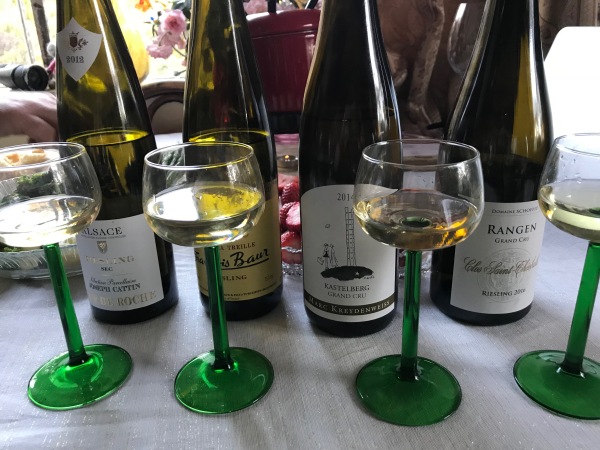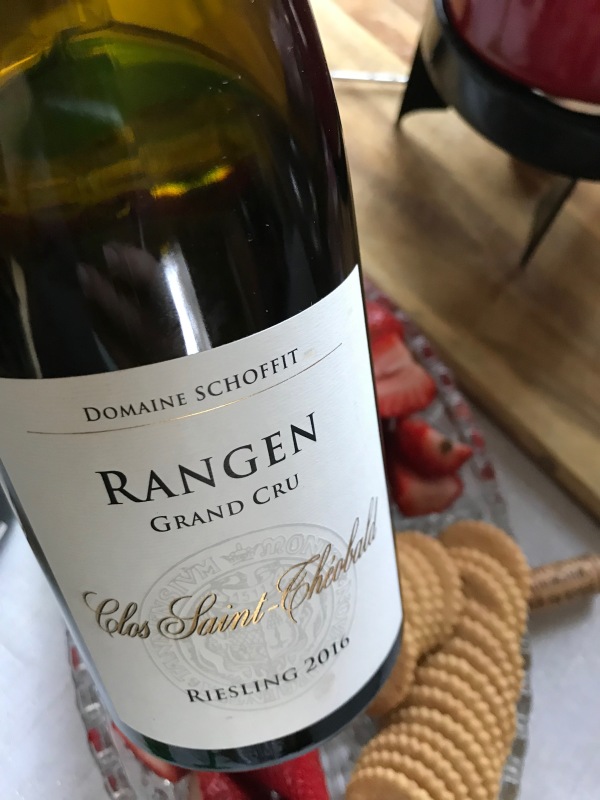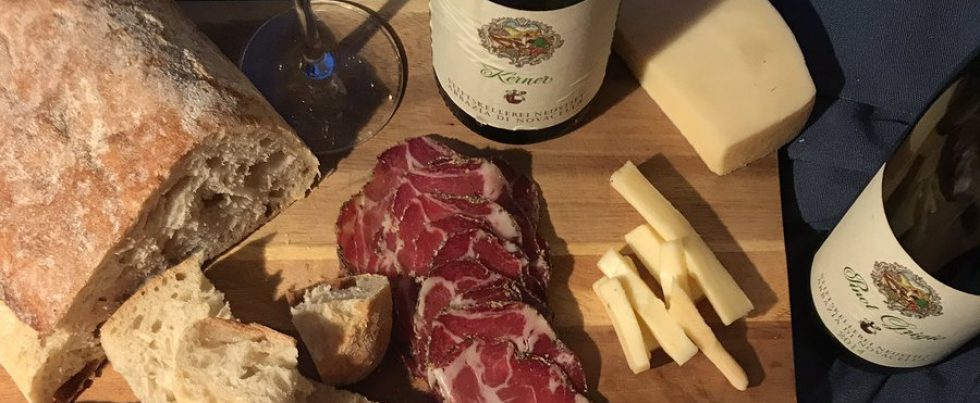
Why does Alsace Rock? (And where is Alsace anyway?) This is what the French Winophiles investigated during the month of June.
Famous for Riesling and scenic views, Alsace is located in northeastern France: Germany is East with the Vosges Mountains in the West and Switzerland in the South. Check out the red region on the map:

According to Wikipedia, “Alsace is a plain surrounded by the Vosges mountains (west) and the Black Forest mountains (east). It creates Foehn winds which, along with natural irrigation, contributes to the fertility of the soil. In a world of agriculture, Alsace has always been a rich region which explains why it suffered so many invasions and annexations in its history.”
Soil diversity in Alsace includes igneous, metamorphic, and sedimentary rocks with various vineyard soil types like marl, sandstone, granite, schist, and volcanic. Most wineries are farmed sustainably with practices including dry farming, organics, and biodynamics.
Organic farming in the region seeks not to combat ‘ “enemies” of the vine, but to contain them while recreating balance, reactivating the life of soils, reinforcing the natural resistance of plants and sustaining natural cycles. It prohibits the use of all synthetic chemical pesticides.” Cellarmasters reduce interventions to preserve the natural evolution of the wine.
While embracing many of the same objectives as organic farming, biodynamic agriculture integrates the vineyard into a complete and self-sustaining ecosystem that returns the earth to balance in the universe by combining agricultural practices with cosmic cycles including the phases of the moon. Two of the four wines we tasted are biodynamic, and I can’t wait to taste more!
WINES: Alsace Terroirs & Riesling Flight
- Joseph Cattin Pur de Roche Riesling 2012
MARL and SANDSTONE $38 - Francois Baur Riesling Grand Cru Brand 2015
BIODYNAMIC; GRANITE $32 - Kreydenweiss Riesling Grand Cru Kastelberg 2014
SCHIST $45Schoffit Riesling Grand Cru Rangen 2016
BIODYNAMC; VOLCANIC $60 - Except for the first one, all of these wines are Grand Cru wines, ie, the most complex, elegant wines you can find in the region, making them a great value when you compare that a Grand Cru in Burgundy starts at $80!
A Menu for Four Riesling
In doing research for our food and wine pairings, I found this recent article: New York City’s Gabriel Kreuther Refines Alsatian Food Into Haute Cuisine — yum!)
But for our food and wine pairings, I suggested to Sue that we do fondue as we hadn’t done it before and it is a classic dish (albeit Swiss). And indeed I found a recipe on the Wines of Alsace website for a savory fondue using Gruyere and Ementhaler Cheeses. For dipping, Sue blanched asparagus spears, zucchini, broccoli, and cauliflower, sliced and quartered a fresh baguette, boiled fresh sausage and brats in wine and sliced after cooking for easy dipping.
I asked Stephanie Teuwen of Teuwen Communications who coordinated the Winophiles event what order we should taste them in and how she likes to pair these wines: “I love cooking scallops for these wines (on the grill, barely two minutes on each side with a drizzle of good olive oil on the plate), smoked fish (salmon, white fish salad on toasted bread), grilled pork chops, barbecue pork chops, and yes, very good cheeses but not too potent so they don’t overwhelm the wines. Can’t wait to hear and read your adventures with the fondue!”
While we loved the Gruyere, it did have a somewhat powerful flavor and I’d like to try Riesling of this quality with something more delicate in flavor so see if I can suss out more of the nuances of the soils. In the following days, I paired the two biodynamic wines with scallops and other seafood as well as a few family favorites. I found the wines quite easy-going and versatile, particularly the more complex Schoffit Riesling Grand Cru Rangen 2016. Perhaps also the subtle smokiness from the volcanic soil lent it to our preferred food prep method: grilling!
For our dessert fondue, we wanted to go away from the normal chocolate fondue, because chocolate and alsace did not sound like a great pairing– in fact chocolate does not pair well with most wines regardless of how many articles and events you might see.
As my lemon tree is brimming in fruit and I saw a pairing for lemon with Riesling, I suggested we do a lemon curd fondue which Sue made by melting mascarpone cheese and lemon curd together in the fondue pot. We dipped fresh berries and lemon coconut cookie wafers. The lemon curd mellows with the mascarpone and really works with the wines.
What a fun evening to have these little bites that all went so nicely with the wines and each brought out a different characteristic in both the wine and the food. This also was a most relaxing evening for us. It is the last week of the school year for Sue, she needed to get the dinner together and the notes typed and then head home to complete the last of her report cards. What and easy meal to throw together which left us a maximum time for tasting, talking and enjoying our wine together. This simple meal was elegant, relaxing, and super enjoyable.

GLASS SHAPE for ALSACE
People make fun of the old school green stemmed Alsace glasses from the 60s and 70s. I inherited a set of four from my grandparents that I am not sure if I have ever used so I got them out and washed them up.
The small traditional Alsace glass brought out “petrol” phenolics and minerals and was the most engaging. The small bowl meant it was easier to take a nice photo with the wine — in the big Riedel Bordeaux glasses it takes a lot of wine to look good!
We savored and sipped these wines even more than usual, pouring and sampling much less wine.
This is something to think about if you are having guests over and want them to sample several wines. This is the glass to go with if you are having an Alsace fondue party: little bites and little sips.

Joseph Cattin Pur de Roche Riesling 2012 – 12.5% alcohol
MARL and SANDSTONE $38
This wine in all four glasses would make you think that you had a different wine in each glass — it’s that distinct.
Color: Golden, silver, platinum.
Nose: Petrol, grass, in our traditional Alsace glass, petrol is forefront. Sue wanted to keep sipping and sniffing the wine out of these traditional glasses, it brought out a nose that was most unfamiliar and interesting
Palate: Petrol, minerals, viscous, lemony citrus. The sauvignon blanc glass delivers the most tang. The stemless sauv blanc glass by Reidel made the wine rather uninteresting.
Pairing: Went great with our fondue cheese and bread. Super yummy with the brats dipped in the fondue. We see why people rave about Alsace wines and a fondue pot. It was also perfect with the berries and lemon curd fondue. I liked the fruit, but really liked the bread with the dessert fondue then went on to mix the bread, fruit and lemon curd fondue. Yum!
While a lovely wine on its own, it was our least favorite of the evening. It fell flat in comparison to the others which are Grand Cru.

Francois Baur Riesling Grand Cru Brand 2015 – 13.0% alcohol
BIODYNAMIC; GRANITE $32
This wine showed well in all of our glasses; it was very consistent and even.
Color: Very clear silver tones, with a touch of silver gold and a slight hint of green.
Nose: Petrol, clean minerals, banana.
Palate: Petrol with bright tropical acidic fruit, with banana and pineapple finish. Super tangy at the tip of the tongue, with that tropical fruit finish that lingers on for a great long time. A fascinating complexity.
Pairing: Nutmeg in the brat marries nicely and brings out a lovely fruitiness in the wine. This wine fought with the dessert a bit more than the first wine.
What an amazing value for a Grand Cru wine.

Kreydenweiss Riesling Grand Cru Kastenberg 2014 – 13.5% alcohol
SCHIST $45
Whimsical fun label, the capsule has interesting detailing of two faces, upon looking closer it is the sun that is on the back of the label. This wine also took on different characteristics with each of the glasses.
Color: Pale golden tones, almost an iridescent daffodil
Nose: Tropical fruit, banana, with an underlying feature of petrol. As it opens, fresh cut grass, then white flowers, carnations, cinnamon, cloves.
Palate: Petrol comes across on the palate, but is not overpowering. Racy on the roof of the palate, nice lingering minerals.
Pairing: The wine brings out the creaminess in the food, like a coconut milk or milk chocolate, and the food tames the raciness of the wine. When paired with fondue, Sue was able to taste the baking spices that I found on the nose.
Sue found this to be an extremely versatile wine; it went across the board with our dinner this evening. It loved the cheese fondue and did not fight with the dessert. The bright fruit with this wine found a lovely greenness. I agreed that this was a lovely pair. She found a honey quality poking through on this pairing.

Schoffit Riesling Grand Cru Rangen 2016 – 13.5% alcohol
BIODYNAMC; VOLCANIC $60
Color: Super pale, gold silver with a green tinge.
Nose: Floral, pretty, like a garden in springtime. Sue felt the nose was incredibly subtle with florals, but not overpowering. Fruit is not overpowering nor overbearing, there is a mineral quality, but again very subtle, and underlying beneath it all is the subtle petrol characteristics. Fascinating!
Palate: Tropical fruit, fresh pineapple on the front of the palate, like a perfectly ripe fresh pineapple. Clean mineral, citrus finish that lingers nicely. A bit of citrus pith and tangerine. Sue got pineapple from end to end. This wine is the most well-balanced and complex, with a great deal of acidity.
Pairing: As with all of the wines this evening, it loved the sausage and fondue, the bread and fondue, the veggies and fondue. This wine as all the others is so incredibly yummy with fondue. This wine also went well with our dessert: the sweetness of the dessert did not overwhelm the wine and brought out lovely fruit and minerals that mingled and married.
After our tasting, I kept the two biodynamic wines to experiment with and Sue took the other two. I did an Asian stir fry one night and scallops and sausage ravioli on another. I took the final glass of the biodynamic Schoffit Riesling Grand Cru Rangen to the Live Oak Music Festival the and shared it with Gustavo who is the tasting room lead at biodynamic Tablas Creek — and it was still fantastic on Sunday paired with cheese and salami. It’s true what they say: biodynamic wine last longer.
Please join our chat on Twitter – whether you posted or not. We love visitors and happily chat and answer questions. Simply tune in to the #winophiles hashtag on Twitter — it will be live this Saturday, June 16 at 10am CDT. You can also check out the #AlsaceRocks hashtag for more Alsace fun during and after the chat. Here’s a list of great Alsace wine suggestions from our Winophiles:
- Robin at Crushed Grape Chronicles shares “A Palette of Pinots – The Hues of Alsace”
- Martin at Enofylz Wine Blog shares “Pinot d’Alsace…Yes Please!”
- Rupal at Syrah Queen shares “Rockin Alsace With Pinots”
- Julia at Julia Coney shares “Alsace – Where Pinot Rocks!“
- Wendy at A Day in the Life on the Farm shares “Alsace Rocks the Summer Grilling Scene”
- Jeff at Food Wine Click! shares “Alsace Wines in the American Kitchen”
- Lauren at The Swirling Dervish shares “Alsatian Temptation: Wine from the Vosges Mountains in France“
- Jane at Always Ravenous shares “Tips and Recipes for Alsace Pairings”
- Camilla at Culinary Adventures with Camilla shares “Alsace Pairing Challenge? Accepted!”
- Olivier at In Taste Buds We Trust shares “Taking gewürztraminer to a higher level”
- Michelle at Rockin Red Blog shares “Getting Dirty with Alsace Riesling“
- Payal at Keep the Peas shares “Alsace: A Geologist’s Dream”
- Jill at L’Occasion shares “A Riesling Experience: Nuanced Terroirs of Alsace”
- Liz at What’s in that Bottle shares “All in for Alsace Riesling”
- David at Cooking Chat shares “Pork and Cabbage Skillet with Riesling from Alsace”
- Here at Wine Predator we are sharing “Alsace Rocks 4 Riesling With Fondue!”







Gwen, I loved your alternate dessert fondue. I’ll need to give that a try. So cool that you have the traditional Alsace wine glasses! When we visited, I didn’t have room to bring any home and now I really wish I had. They are unique and classic.
LikeLiked by 1 person
I love that you have Alsace wine glasses. We saw them while there – so cute! I love your fondue pairings. Well done.
LikeLiked by 1 person
Great post, Gwen! Love your experimentation with the glassware and I’m with Jeff on that lemon fondue for dessert – how creative and fun!
LikeLiked by 1 person
I love that you tasted in multiple glasses. It is amazing how much the shape of the glass, the size, the thickness of the rim…can all affect how the wine hits your nose and your palate. I was not familiar with the Alsace wine glass style and had to go look them up! With as much as I am enjoying Alsatian wines, I may need to invest in a set!
LikeLiked by 1 person
I love fondue — You might have inspired me to bust out my pot sometime soon. And what a great idea to do lemon curd fondue! So interesting to hear your notes from various glasses.
LikeLiked by 1 person